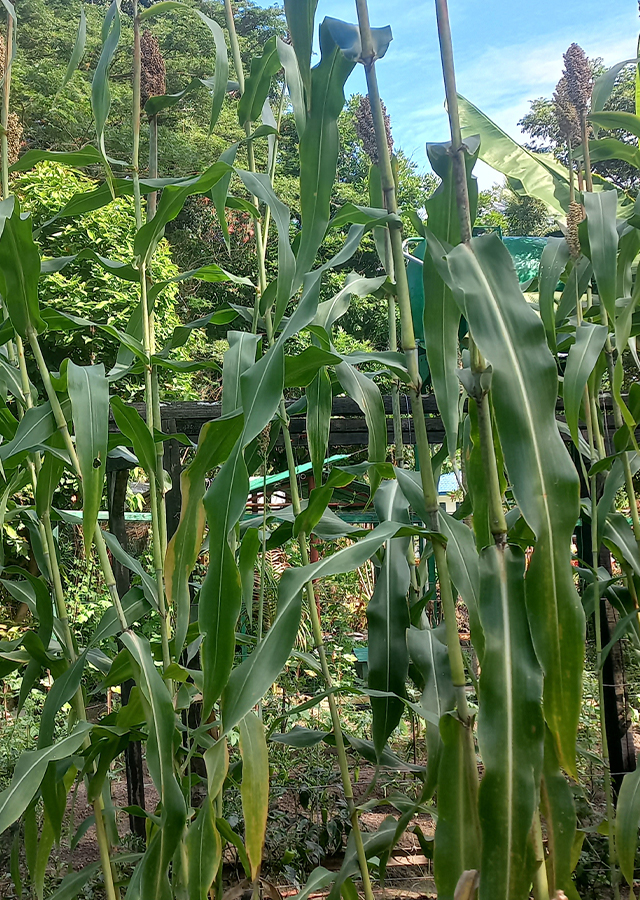Sorghum
Sorghum bicolor (L.) Moench
Poaceae
Location in our garden
Vegetable



Synonym
Andropogon bicolour (L.) Roxb.
Andropogon bicolour Nees
Andropogon caffrorum (Thunb.) Kunth
Habitus
Herbaceous. A vigorous, erect, annual grass that can grow up to 5 m tall
Part Used
Leaves
Seeds
Flowers
Twigs
Growing Requirements
Full Sunshine
Need Shade
Drought Resistant
Habitat
Terrestrial
Overview
Sorghum is a warm-season cereal of African origin, which was first cultivated in the region of Ethiopia or Chad over 5,000 years ago. It spread to India by 4,000 years ago and later to China and to southern Africa by about 1,500 years ago. Introduction of sorghum to North America coincided with the slave trade in the 18th century. It is the world's fifth most important cereal after maize, rice, wheat, and barley. Sorghum grain is gluten free and is a good substitute for cereal grains for individuals with celiac disease. Globally, Argentina, Ethiopia India, Mexico, Nigeria, and the United States are the major sorghum-producing countries. Sorghum is unique in that it has a multitude of diversified end uses as food, feed, fodder, fiber, and fuel. Sweet sorghum varieties can be processed into syrups and molasses. The grain is a major food in most of Africa, Asia, and Central America, while it is an important animal feed in the Americas and Australia.
Vernacular Names
Sorgo forrajero (Spanish), Durra (Africa).
Agroecology
Sorghum is a plant of the tropics and subtropics, where it is found main in semi-arid areas and at elevations up to 2,500 m. It grows best in areas where annual daytime temperatures are within the range 22-35 °C.It prefers a mean annual rainfall in the range 400-600 mm, but tolerates 300-700 mm. A fairly easily grown plant, requiring a warm, sheltered and sunny position, preferring a slightly to moderately acid soil though some cultivars have succeeded with a pH as high as 8. Plants are adapted to a wide range of soils varying from light loams to heavy clays, they thrive best on light, easily worked soils of high fertility, with moderate to high availability of water. Moderately well-drained soils are suitable for sorghums. Prefers a pH in the range 5.5-7.5. Small amounts of alkali in sand reduces performance considerably. Plants are moderately tolerant of saline soils. Established plants are very drought resistant, they succeed in arid and nutrient-poor soils. Sorghum is not tolerant of frost, shade, or sustained flooding.
Morphology
- Stems - rigid, and there are no creeping rhizomes, loose, open panicle of short, few-flowered racemes.
- Leaves - cauline, with base broadly rounded. Leaf blade measures from 30-100 cm long and 5-10 mm wide, glabrous and waxy. Leaf sheaths encircle the culms and have overlapping margins.
- Flowers - panicles up to 40 cm long, loose and open. Spikelets are sessile, measuring up to 6 mm long. Upper branches tend to droop.
- Fruits - caryopsis (seed) is exposed when matures. As seed matures, the panicle may droop. Glumes vary in color from red or reddish brown to yellowish and are at least three quarters as long as the elliptical grain.
Cultivation
Sorghum is propagated generatively from seed. Soil temperatures of at least 18.3 °C are required for germination. Ideally, seeds should be sown in a finely prepared seed bed but seeds are often sown in furrows following plowing or broadcast. A wide range of row spacings are used successfully in sorghum cultivation with the final spacings being dependent of climatic conditions and available moisture. Under favorable conditions for sorghum growth, plants should be spaced 12–20 cm apart, allowing 45–60 cm between rows. Sorghum can be harvested by hand or by combine. When harvesting by hand, the heads or whole plants may be cut. Sorghum should be harvested when the grain moisture content is between 18 and 23% and may be ready for harvest when the leaves are still green.
Chemical Constituents
Tannins, phenols, phenolic compounds, flavonoids, phytosterols, policosanols, carotenoids, anthocyanins.
Traditional Medicinal Uses
- Ethno-botanical reports showed that decoction from Sorghum bicolor seed possessed demulcent, diuretic, emollient, remedy for cancer, epilepsy, flux, treatment of kidney, and stomach ache.
- The inflorescence is astringent and haemostatic.
- The leaves and panicles are included in plant mixtures for decoctions used in the treatment of anaemia.
- Decoctions of the twigs, combined with lemon, is used as a treatment against jaundice. The red pigment is said to have antimicrobial and antifungal properties. It is used as a treatment for anaemia
Part Used
Reference Sources
- Fern, Ken. (2021). Useful Tropical Plants Database: Sorghum bicolor. https://tropical.theferns.info/viewtropical.php?id=Sorghum+bicolor. 05-01-2022.
- Kew Royal Botanic Gardens. (2021). Plants of the World Online: Sorghum bicolor (L.) Moench. https://powo.science.kew.org/taxon/urn:lsid:ipni.org:names:422090-1. 05-01-2022.
- National Park of Singapore. (2019). Flora Fauna Web: Sorghum bicolor. https://www.nparks.gov.sg/florafaunaweb/flora/7/1/7163. 05-01-2022.
- North Carolina Cooperative Extension. (No date). North Carolina Extension Gardener Plant Toolbox: Sorghum bicolor. https://plants.ces.ncsu.edu/plants/sorghum-bicolor/. 05-01-2022.
- Plant Village. (No date). Sorghum. https://plantvillage.psu.edu/topics/sorghum/infos. 05-01-2022.
- Salazar-Lopez, N.J., Gonzalez-Aguilaro, G. et al. (2018).Technologies applied to sorghum (Sorghum bicolor L. Moench): changes in phenolic compounds and antioxidant capacity. Food Sci. Technol 38 (3). https://doi.org/10.1590/fst.16017 .
- Science Direct. (2019). Sorghum Bicolor-Related Terms. https://www.sciencedirect.com/topics/agricultural-and-biological-sciences/sorghum-bicolor. 05-01-2022.
- USDA NRCS. (2013). Plant Guide: Sorghum. https://www.nrcs.usda.gov/Internet/FSE_PLANTMATERIALS/publications/azpmcpg11583.pdf. 05-01-2022.



